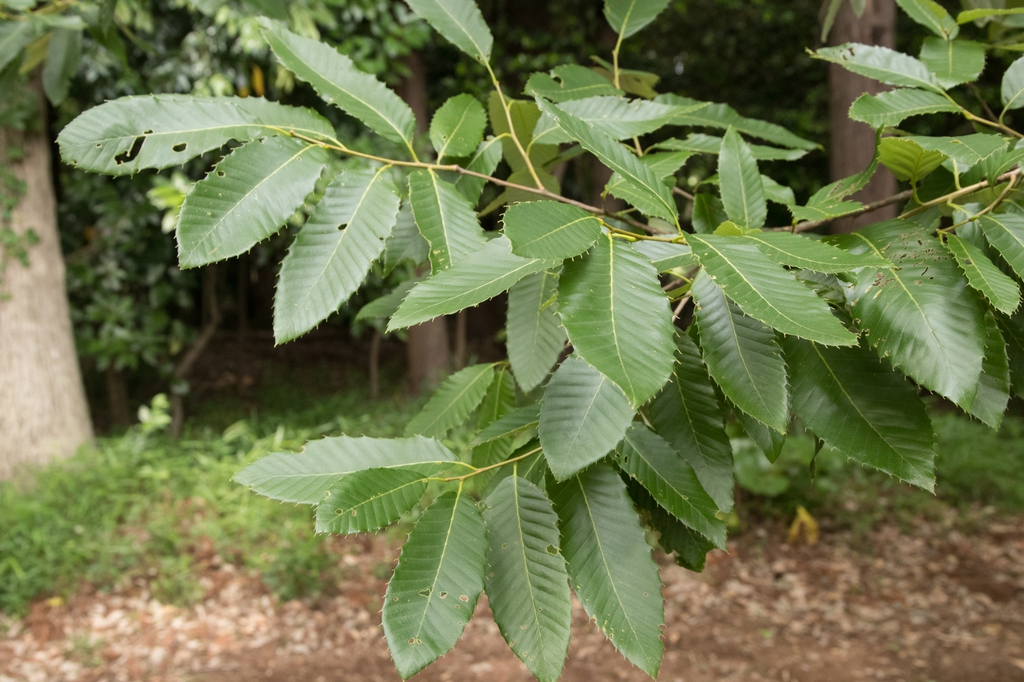Quercus variabilis
Common Name(s):
- Phonetic Spelling
- KWER-kus var-ee-AH-bil-iss
- Description
-
Oriental Cork Oak is a medium to large tree from Asia with thick, corky bark and chestnut type leaves. It is quite ornamental in appearance. It prefers moist, well-drained clay to sandy loam soils and full sun but will tolerate some shade. Oriental Oak is rarely grown in the US but can be used as a shade, street or ornamental tree.
- See this plant in the following landscape:
- Cultivars / Varieties:
-
- Tags:












- Cultivars / Varieties:
-
- Tags:
-
-
Attributes:
- Genus:
- Quercus
- Species:
- variabilis
- Family:
- Fagaceae
- Uses (Ethnobotany):
- Bark can be used for cork production
- Life Cycle:
- Woody
- Recommended Propagation Strategy:
- Seed
- Country Or Region Of Origin:
- Asia
- Wildlife Value:
- Oak trees support a wide variety of Lepidopteran. You may see Imperial Moth (Eacles imperialis) larvae which have one brood per season and appear from April-October in the south. Adult Imperial Moths do not feed. Banded Hairstreak (Satyrium calanus), which have one flight from June-August everywhere but Florida where they emerge April-May. Edward's Hairstreak (Satyrium edwardsii), has one flight from May-July in the south and June-July in the north. Gray Hairstreak (Strymon melinus), has three to four flights in the south from February-November and two flights in the north from May-September. White-M Hairstreak (Parrhasius m-album) has three broods in the north from February-October. Horace’s Duskywing (Erynnis horatius) has three broods in Texas and the deep south from January-November, and two broods in the north from April-September. Juvenal’s Duskywing (Erynnis juvenalis) has one brood from April-June, appearing as early as January in Florida. Mildly resistant to deer damage.
- Edibility:
- Acorns can be eaten after the tannin is leached or boiled out.
- Dimensions:
- Height: 60 ft. 0 in. - 80 ft. 0 in.
- Width: 60 ft. 0 in. - 75 ft. 0 in.
-
-
Whole Plant Traits:
- Plant Type:
- Poisonous
- Tree
- Woody Plant Leaf Characteristics:
- Deciduous
- Habit/Form:
- Erect
- Open
- Growth Rate:
- Slow
- Maintenance:
- Medium
- Texture:
- Medium
-
-
Cultural Conditions:
- Light:
- Full sun (6 or more hours of direct sunlight a day)
- Soil Texture:
- Clay
- Loam (Silt)
- Sand
- Soil Drainage:
- Good Drainage
- Moist
- Occasionally Dry
- NC Region:
- Coastal
- Mountains
- Piedmont
- USDA Plant Hardiness Zone:
- 5a, 5b, 6a, 6b, 7a, 7b, 8a, 8b
-
-
Fruit:
- Fruit Color:
- Brown/Copper
- Display/Harvest Time:
- Fall
- Fruit Type:
- Nut
- Fruit Length:
- < 1 inch
- Fruit Width:
- < 1 inch
- Fruit Description:
- The 5/8 inch brown acorn is round and two-thirds enclosed in the cup, which is densely covered in soft 'mossy' bristles. Matures in 2 years.
-
-
Flowers:
- Flower Inflorescence:
- Catkin
- Insignificant
- Flower Bloom Time:
- Spring
- Flower Description:
- Male flowers appear as drooping catkins, female flowers in clusters.
-
-
Leaves:
- Woody Plant Leaf Characteristics:
- Deciduous
- Leaf Color:
- Green
- White
- Leaf Type:
- Simple
- Leaf Arrangement:
- Opposite
- Leaf Shape:
- Lanceolate
- Ovate
- Leaf Margin:
- Serrate
- Hairs Present:
- Yes
- Leaf Length:
- > 6 inches
- Leaf Width:
- 1-3 inches
- Leaf Description:
- The 6-inch leaves are elongate with serrate margin and white pubescence on the underside. Each leaf has 13-18 pairs of parallel side veins each of which ends at the leaf margin in a tiny bristle-like tooth. Young trees hold their leaves into winter.
-
-
Bark:
- Bark Color:
- Light Gray
- Surface/Attachment:
- Ridges
- Bark Description:
- The yellowish-gray bark is thick and corky with deep fissures and marked by sinuous ridges
-
-
Stem:
- Stem Color:
- Brown/Copper
- Gray/Silver
- Green
- Stem Is Aromatic:
- No
- Stem Bud Terminal:
- Cluster of terminal buds
- Stem Cross Section:
- Round
- Stem Surface:
- Smooth (glabrous)
- Stem Description:
- Twigs are olive-brown to pale brown, almost hairless, somewhat shiny, becoming grey-brown with age.
-
-
Landscape:
- Landscape Location:
- Lawn
- Woodland
- Landscape Theme:
- Butterfly Garden
- Nighttime Garden
- Pollinator Garden
- Design Feature:
- Shade Tree
- Specimen
- Street Tree
- Attracts:
- Butterflies
- Moths
- Pollinators
- Resistance To Challenges:
- Deer
- Drought
- Problems:
- Problem for Horses






